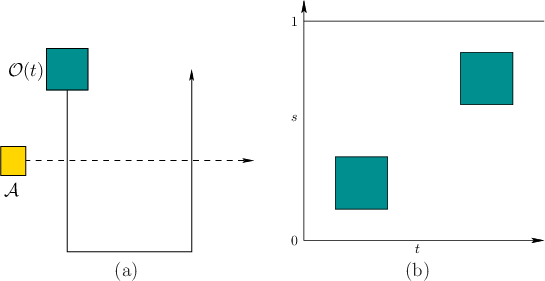
Next: 7.2 Multiple Robots Up: 7.1 Time-Varying Problems Previous: Bounded speed
An alternative to defining the problem in
![]() is to decouple
it into a path planning part and a motion timing part
[506]. Algorithms based on this method are not complete,
but velocity tuning is an important idea that can be applied
elsewhere. Suppose there are both stationary obstacles and moving obstacles. For the stationary obstacles, suppose that some
path
is to decouple
it into a path planning part and a motion timing part
[506]. Algorithms based on this method are not complete,
but velocity tuning is an important idea that can be applied
elsewhere. Suppose there are both stationary obstacles and moving obstacles. For the stationary obstacles, suppose that some
path
![]() has been computed using any of
the techniques described in Chapters 5 and
6.
has been computed using any of
the techniques described in Chapters 5 and
6.
The timing part is then handled in a second phase. Design a
timing function (or time scaling),
![]() , that indicates for time,
, that indicates for time, ![]() , the location of the robot along
the path,
, the location of the robot along
the path, ![]() . This is achieved by defining the composition
. This is achieved by defining the composition
![]() , which maps from
, which maps from ![]() to
to
![]() via
via ![]() .
Thus,
.
Thus,
![]() . The configuration at time
. The configuration at time ![]() is expressed as
is expressed as
![]() .
.
A 2D state space can be defined as shown in Figure 7.4.
The purpose is to convert the design of ![]() (and consequently
(and consequently
![]() ) into a familiar planning problem. The robot must move along
its path from
) into a familiar planning problem. The robot must move along
its path from ![]() to
to ![]() while an obstacle,
while an obstacle,
![]() ,
moves along its path over the time interval
,
moves along its path over the time interval ![]() . Let
. Let ![]() denote the domain of
denote the domain of ![]() . A state space,
. A state space,
![]() , is shown
in Figure 7.4b, in which each point
, is shown
in Figure 7.4b, in which each point ![]() indicates
the time
indicates
the time ![]() and the position along the path,
and the position along the path,
![]() .
The obstacle region in
.
The obstacle region in ![]() is defined as
is defined as
| (7.5) |
 |
Any of the methods described in Formulation 7.1 can be
applied here. The dimension of ![]() in this case is always
in this case is always ![]() . Note
that
. Note
that ![]() is polygonal if
is polygonal if ![]() and
and ![]() are both polygonal regions
and their paths are piecewise-linear. In this case, the vertical decomposition method of Section
6.2.2 can be applied by sweeping along the time axis to
yield a complete algorithm (it is complete after having committed to
are both polygonal regions
and their paths are piecewise-linear. In this case, the vertical decomposition method of Section
6.2.2 can be applied by sweeping along the time axis to
yield a complete algorithm (it is complete after having committed to
![]() , but it is not complete for Formulation 7.1). The
result is shown in Figure 7.5. The cells are
connected only if it is possible to reach one from the other by
traveling in the forward time direction. As an example of a
sampling-based approach that may be preferable when
, but it is not complete for Formulation 7.1). The
result is shown in Figure 7.5. The cells are
connected only if it is possible to reach one from the other by
traveling in the forward time direction. As an example of a
sampling-based approach that may be preferable when ![]() is not
polygonal, place a grid over
is not
polygonal, place a grid over ![]() and
apply one of the classical search algorithms described in Section
5.4.2. Once again, only path segments in
and
apply one of the classical search algorithms described in Section
5.4.2. Once again, only path segments in ![]() that move
forward in time are allowed.
that move
forward in time are allowed.
Steven M LaValle 2020-08-14